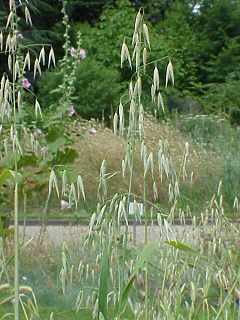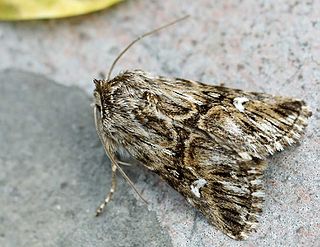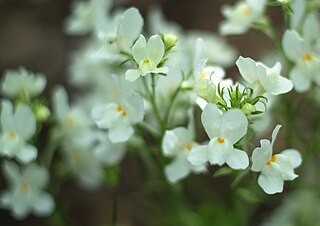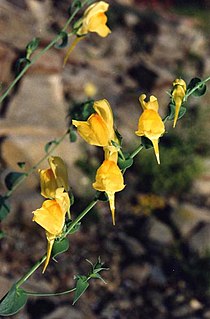
Avena is a genus of Eurasian and African plants in the grass family. Collectively known as the oats, they include some species which have been cultivated for thousands of years as a food source for humans and livestock. They are widespread throughout Europe, Asia and northwest Africa. Several species have become naturalized in many parts of the world, and are regarded as invasive weeds where they compete with crop production. All oats have edible seeds, though they are small and hard to harvest in most species.

The twite is a small brown passerine bird in the finch family Fringillidae.

The common linnet is a small passerine bird of the finch family, Fringillidae. It derives its common name and the scientific name, Linaria, from its fondness for hemp seeds and flax seeds—flax being the English name of the plant from which linen is made.

Linaria is a genus of 150 species of flowering plants, one of several related groups commonly called toadflax. They are annuals and herbaceous perennials, and the largest genus in the Antirrhineae tribe of the plantain family Plantaginaceae.

Adonis is a genus of about 20–30 species of flowering plants of the crowfoot family, Ranunculaceae, native to Europe and Asia.
Linaria ricardoi is a rare Portuguese endemic plant species in the family Plantaginaceae. It blossoms from March to April.

Sander is a genus of predatory ray-finned fish in the family Percidae, which also includes the perches, ruffes, and darters. They are also known as "pike-perch" because of their resemblance to fish in the unrelated Esocidae (pike) family. They are the only genus in the monotypic tribe Luciopercini, which is one of two tribes in the subfamily Luciopercinae,

Linaria vulgaris, the common toadflax, yellow toadflax or butter-and-eggs, is a species of flowering plant in the family Plantaginaceae, native to Europe, Siberia and Central Asia. It has also been introduced and is now common in North America.

Nuttallanthus canadensis, the blue toadflax, Canada toadflax, or old-field toadflax, is a species of Nuttallanthus in the family Plantaginaceae, native to eastern North America from Ontario east to Nova Scotia and south to Texas and Florida.

Sander volgensis, the Volga pikeperch or Volga zander, is a species of fish in the perch family Percidae. It is found in Austria, Azerbaijan, Bosnia and Herzegovina, Bulgaria, Croatia, Hungary, Moldova, Romania, Russia, Serbia, Slovakia, and Ukraine.

The Circumboreal Region in phytogeography is a floristic region within the Holarctic Kingdom in Eurasia and North America, as delineated by such geobotanists as Josias Braun-Blanquet and Armen Takhtajan.

Calophasia lunula is a Palearctic species of noctuid moth known by the common names toadflax moth and toadflax brocade moth.

Linaria bipartita is a species of flowering plant in the plantain family known by the common name clovenlip toadflax. It is native to Morocco, but it can be found elsewhere as an introduced species and it is cultivated as an ornamental plant. It is an annual herb growing 10 to 30 centimeters tall with linear leaves 3 to 5 centimeters in length. The inflorescence is a raceme of flowers occupying the top of the stem. The flower is about 2 centimeters long with five lobes arranged into two lips with a spur at the end. The flower is often reddish purple in color, but flowers of many different colors are bred for the garden. The fruit is a spherical capsule about 2 millimeters wide.

Linaria maroccana is a species of flowering plant in the plantain family known by the common names Moroccan toadflax and annual toadflax. It is native to Morocco, but it can be found elsewhere growing wild as an introduced species, such as California. It is a readily available ornamental plant for the flower garden. This is an annual herb growing erect to approach a maximum height of 50 cm (20 in), its stem with linear leaves 2–4 cm (0.8–1.6 in) long. The inflorescence is a raceme of flowers occupying the top of the stem. At the base of each flower is a calyx with five narrow, pointed lobes. The flower is 2–4 cm (0.8–1.6 in) long with five lobes arranged into two lips with a spur at the end. The flower is often purple in color with white near the throat, but flowers of many different colors are bred for the garden. Dwarf cultivars are also available.

Linaria purpurea is a species of flowering plant in the plantain family known by the common name purple toadflax.

Linaria dalmatica is a herbaceous plant native to western Asia and southeastern Europe that has become a weed in other areas. Its common names include Balkan toadflax, broadleaf toadflax, and Dalmatian toadflax.
Jordanita volgensis is a moth of the family Zygaenidae. It is known from eastern Ukraine, southern Russia, Transcaucasia, Turkey and Syria.
Pterophorus volgensis is a moth of the family Pterophoridae. It is found in Russia.

The Antirrhineae are one of the 12 tribes of the family Plantaginaceae. It contains the toadflax relatives, such as snapdragons.

Linaria arenaria, sometimes called sand toadflax or French toadflax, is a yellow-flowered member of the genus Linaria. It is found in sand-dunes and sandy grassland in western France, north-west Spain and Portugal and is thus a psammophyte plant. It is found casually in England and reliably at two sites. One is Braunton Burrows in north Devon where it was planted around 1893 and continues to grow, and the other, since 2004, is in north Somerset.
















